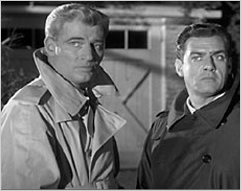Perry Mason continued for nine seasons, an accomplishment few shows ever achieve. In the end it succumbed to many of same factors that ended the film noir genre on the big screen. When Perry Mason went on the air in 1957 all of prime time television was broadcast in black and white. By 1966 virtually all all of the network shows were in color. If the show was going another season then CBS wanted it in color. To that end, The Case of the Twice-
Although the show had been out of the top 25 for several seasons, it was still popular and profitable for CBS. Even so, there were those within CBS who were undoubtedly wrapped in their demographic surveys which Perry Mason no longer fit. Gardner himself didn’t seem to care. He was then 76 years old and had achieved just about everything he ever wanted. The character he created some 35 years earlier (which some argue was his alter-
Raymond Burr reprised his role as Perry Mason in 1985 in what would become a series of two hour dramas. Three or four shows aired each year until Burr’s death in 1993. These shows received good ratings as Perry Mason fans were undoubtedly happy to see Burr and Barbara Hale back together but in terms of visual style the show had little relevance to the original series.
The Perry Mason television series came along at the right time in the right format with a style that evoked noir. The series benefited by that style and it was most certainty a factor in its success.



The femme fatale was someone to avoid in noir. They were just as deadly in Perry Mason. From left: Virginia Greeg in The Case of the Cautious Coquette, Helen Stanley and Ruta Lee in The Case of the Footloose Doll, Andrea King in The Case of the Bedeviled Doctor and June Dayton in The Case of the Ill-
One of the distinctive characteristics of noir is the dark, shadowy atmosphere and Perry Mason made effective use of it. From left: Frainkie Laine mulls over his next move in The Case of The Jaded Joker, your sense tells you that nothing good can come from this motel scene in The Case of the Romantic Rogue, ominous crime scene in The Case of the Prodigal Parent and Theodore Marcuse
cast noirish shadows in The Case of the Shattered Dream.

Noir tough guy Ted de Corsia in TCOT Positive Negative
Elishia Cook Jr played the same quirky characters as he did in noir.
Seen here in TCOT Pint Sized Client.
What else but a femme fatale would you expect from Marie Windsor in TCOT Deadly Decoy.
The conniving Berry Kroeger in TCOT Lame Canary, one of seven appearances he made in the series.


William Talman and Raymond Burr had spent most of their careers playing villains in
film noir. In Perry Mason they were much more amicable characters.
Burr spent as much time sleuthing as he did in the courtroom .


